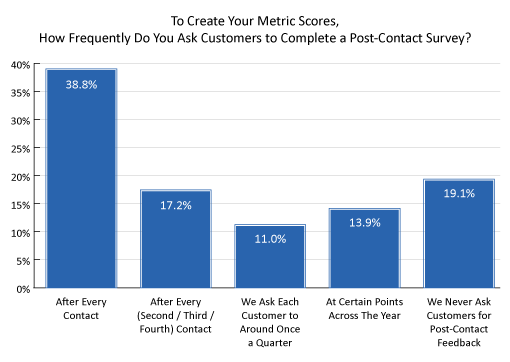Post call surveys have become a key tool for contact centres seeking to enhance customer experience and optimize service performance.
These surveys provide businesses with valuable real-time feedback, allowing them to make data-driven decisions to improve interactions.
In this article, we’ll explore what these surveys are, who uses them, their benefits and limitations, and best practices for implementation.
What Is a Post Call Survey?
A post call survey (also known as a post-contact survey or an after-call survey) is designed to gather immediate feedback from customers about their experience during the call.
It typically includes questions that assess service quality, the helpfulness of the agent, and overall satisfaction.
These surveys can be delivered via automated phone systems, emails, SMS, or web links, and often feature both rating scales and open-ended questions to gather quantitative and qualitative feedback.
Additionally, many post call surveys are integrated with CRM systems, linking survey results to specific customer interactions for more personalised insights. The goal is to not only measure satisfaction but also identify areas for improvement in service delivery.
Why Send Out a Post Call Survey?
Post call surveys are commonly initiated by departments that focus primarily on the customer experience, such as call centres and customer support teams.
These teams are responsible for directly engaging with customers, handling inquiries, and resolving issues, making their feedback essential for assessing service quality and overall performance.
The surveys offer a structured way to gather this feedback, enabling companies to evaluate how well their service teams are meeting customer expectations.
The insights gathered serve multiple purposes, including:
Scoring Customer Interactions to Track Performance Over Time
This includes working out customer satisfaction (C-SAT) scores to show how well the organization is performing, as well as determining NetPromoter Scores to track customer loyalty.
Feedback Collection
Surveys provide a direct channel for customers to express their opinions and provide feedback on their experiences.
Insight Generation
Data collected from these surveys helps organizations identify patterns and trends in customer interactions, allowing them to make informed improvements.
Customer-Centricity
By actively seeking feedback, companies demonstrate their commitment to listening to customers and addressing their concerns.
Performance Measurement
Post call surveys also help in evaluating the effectiveness of frontline agents and identifying areas for training and development.
As Jennifer Passini at NICE elaborates in our What Is an After-Call Survey? article, “For contact centre supervisors, after-call surveys are also helpful in improving overall performance for that touchpoint, as they highlight the metrics most important to customer satisfaction and areas for improvement to guide coaching and training for agents.”
What Typically Happens to the Data Collected From a Post Call Survey?
In a proactive organization, data and responses from post call surveys are analysed to extract meaningful insights.
These insights help businesses understand pain points, strengths, and areas of opportunity within their customer service operations.
The data can also be used to benchmark performance, track improvements over time, and guide strategic decision-making.
For some, however, post call surveys are merely a tick-box exercise and the opportunity is lost to fully utilize these insights to improve the customer experience.
For advice on how often companies should seek customer feedback, read our article: How Often You Should Seek Customer Feedback
A Quick Overview of the Pros and Cons of Post Call Surveys
Here are a few key pros and cons to be aware of when running post call surveys:
Pros of Post Call Surveys:
- Immediate Feedback – Real-time responses capture the customer’s emotions and experiences accurately.
- Actionable Insights – Direct customer feedback allows for targeted improvements and enhancements.
- Employee Development – Surveys help identify training needs and enable the growth of frontline agents.
- Customer Engagement – Inviting customers to share their opinions enhances engagement and builds trust.
Cons of Post Call Surveys:
- Response Bias – Some customers might provide overly positive or negative feedback, skewing the results. This is because the mostly likely people to complete a survey are the happiest or angriest customers.
- Limited Scope – Surveys often focus on a single interaction, possibly missing the bigger picture.
- Time Constraints – Customers may find surveys time-consuming and choose to skip them.
- Data Gaps – The engagement and completion rates of post call surveys vary widely depending on factors like industry, customer demographics, and survey design. On average, completion rates can range from 10% to 30%, so there will always be data gaps.
When’s the Best Time to Send Out a Post Call Survey?
The optimal time to send the survey is immediately after the customer interaction. The experience is fresh in the customer’s mind, ensuring that their responses are accurate and reflective of their emotions during the call.
However, there’s some debate around this, as we learnt on our visit to the ManyPets contact centre in Birmingham (UK):
“The ManyPets team have found that surveying a customer immediately after a call is not always reflective of the whole experience, as they have yet to see the agreed outcomes be delivered.
Instead, they send an email survey within 24 hours of the conversation, so the customer has chance to reflect on the whole experience – when the agent has done what they said they’d do.”
Furthermore, not every contact centre sends out a survey after every call. As the findings of our What Contact Centres Are Doing Right Now showed that less than half of contact centres (38.8%) ask their customers to complete a post-contact survey ‘aft

Dos and Don’ts of Post Call Surveys
Here’s a quick overview of some dos and don’ts for post call surveys:
Dos of Post Call Surveys:
- Keep It Concise – Limit the number of questions to ensure higher completion rates.
- Be Specific – Ask targeted questions about different aspects of the customer’s experience.
- Use Multiple Choice – Mix open-ended questions with multiple-choice questions for ease of response.
- Act on Feedback – Demonstrate responsiveness by making improvements based on customer feedback.
- Test and Refine – Continually evaluate and adjust the survey based on customer preferences.
Don’ts of Post Call Surveys :
- Overwhelm With Questions – Avoid long surveys that can frustrate customers and lower completion rates.
- Use Leading Questions – Ensure questions are neutral and unbiased to get accurate responses.
- Neglect Follow-Up – Always close the loop with customers, informing them of changes made due to their feedback.
- Ignore Negative Feedback – Negative feedback is an opportunity for improvement. Don’t dismiss it!
Alternatives to Post Call Surveys
While post call surveys are a popular tool, there are several viable alternatives for gathering customer insights, including:
- Social Media Listening – Monitoring social media platforms for customer comments and feedback.
- Customer Advisory Boards – Forming panels of selected customers for regular feedback sessions.
- In-App Feedback – Collecting feedback within digital applications or websites immediately after interactions.
- Speech, Text, and Sentiment Analysis – Mining customer interactions such as calls, chat logs and emails for sentiment and feedback. Such solutions are available from 8×8, Calabrio, CallMiner, Diabolocom, Genesys, MaxContact, NICE, Scorebuddy, Talkdesk, Uniphore, and more.
If you are looking for more great insights and advice on customer surveys, then you should read these articles next:
- 22 Top Tips to Improve your Customer Surveys
- Post-call IVR Surveys: When and How to Get the Best out of Them
- Customer Service Surveys – Bringing Sanity to the Survey
- 25 Ways to Improve Your Customer Satisfaction Surveys
Author: Megan Jones
Reviewed by: Jonty Pearce
Published On: 25th Sep 2023 - Last modified: 22nd Oct 2025
Read more about - Customer Service Strategy, 8x8, An Introduction to Contact Centres, Calabrio, CallMiner, Customer Feedback, Diabolocom, Genesys, MaxContact, NiCE, Scorebuddy, Service Strategy, Talkdesk, Uniphore, Voice of the Customer











































